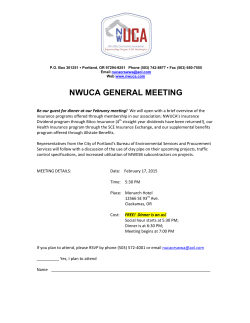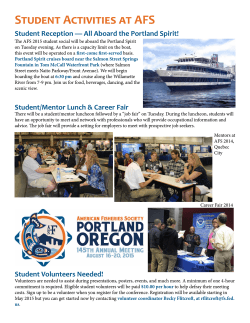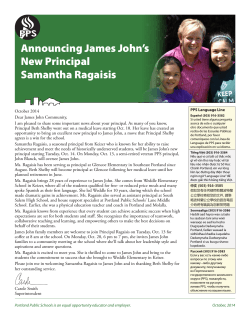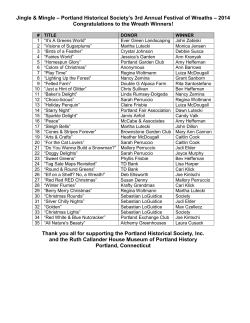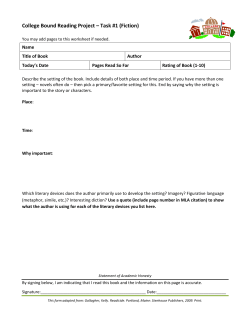
30 Electric-powered public transport in Portland, Oregon: toward greater sustainability Tuck Wilson, a veteran of 30 plus years as Special Counsel for the Portland area's transit agency, has specialized in extending light rail and streetcar systems since 1981. Reflecting his continuing commitment to sustainable practices, he has remained an active supporter of environmental organizations such as The Climate Institute, for which he serves as a member of its Board of Advisors. Tuck Wilson Special Counsel for the Portland Area's Transit Agency Portland, Oregon, is a metropolis of 2.3 million people located on the West Coast of the United States. To the north are the state of Washington and the Canadian province of British Columbia. California lies to the south. The city takes pride in its international reputation as a leader in urban sustainability. Portland adopted a Climate Action Plan in 1993, the first city in the U.S. to do so. By 2013 carbon emissions had dropped by 14 percent below 1990 levels, even as population grew 30 percent. These impressive results are in part due to a concerted focus on improving transportation and access for its citizens. Founded in 1851, Portland was a young town in the late nineteenth century when it experienced its first transportation boom. From a single horse-drawn streetcar in 1872, by 1916 a network of some 300 miles of electric street car and interurban rail lines carried passengers to all corners of the metropolitan Envirocities eMagazine area. Land developers laid streetcar tracks to attract homebuyers to new neighborhoods. The boom era of rail transportation ended in Portland, as in cities all over the country, with the rise of automobile ownership. By the 1920s millions of Americans were driving machines produced by Hen- ry Ford’s assembly line. All these new cars needed new roads. Roads were paved, new highways were built and rail lines closed. By 1950 streetcars had all but disappeared, while improved highways prompted the appearance of new homes in outlying suburbs— the uniquely American “sprawl.” The ascendance of the automobile reached its peak in Portland in the 1960s. Multiple car households became the norm. Miles driven grew annually. By 1970, Portland and its neighboring towns and cities had approved a massive highway construction plan and were beginning to build. 31 Issue 11, May 2015 That same year, the tide began to turn. Across the country concern about polluted air and water gave rise to what has become known as the environmental movement, marked by the first Earth Day and the first of a wave of progressive federal legislation aimed at environmental protection. Construction of this first link in Portland’s MAX light rail network began in 1982. Several hundred thousand citizens turned out for free rides and community events on the opening weekend for the new service, September 5, 1986. Portlanders in many ways were in the vanguard of this first popular expression of what we now know as “sustainability.” By the mid 1970s Portland had replaced a major downtown thoroughfare next to the iconic Willamette River with a burst of green parkland. Portland, other metropolitan communities and the state had called a halt to plans to build a major new roadway, the Mt. Hood Freeway, through the middle of some of Portland’s oldest neighborhoods. State legislators enacted a law requiring municipalities to develop “urban growth boundaries” within which new development would be contained, while farms and forests would continue to flourish outside the boundaries. The rebirth of Portland’s sustainable rail transit network was at hand. A challenging project to extend MAX 18 miles to the western suburb of Hillsboro The stage was set for expansion of public transit, including the rebirth of pollution-free streetcar and light rail lines. By 1980, plans had been drawn for new light rail service from downtown Portland 15 miles due east to Gresham, on the eastern edge of suburban development. Brilliantly, elected leaders managed to gain approval to use federal funds, once meant for the defunct Mt. Hood Freeway, to fund the new light rail line along with safety upgrades to the adjacent existing freeway. A Magazine for the Environmental Center for Arab Towns 32 was approved in 1990, funded largely with federal transit monies. The route needed to negotiate a ridge of hills 1,000 feet high that hemmed in Portland’s downtown. The solution was twin three-mile tunnels; their construction took four years. In September 1998 the opening of the new line meant the Portland region’s principal commuting routes from suburb to central city offered a speedy, modern option of light rail transit. In 1999 this 33-mile MAX line carried 55,000 daily riders. Today there are three additional lines and another one opening in fall 2015, for a combined total Envirocities eMagazine of 60 miles of light rail.Ridership has tripled. New links include the first rail transit service to a West Coast urban airport, which opened in 2001. The first MAX line heading north began carrying passengers in 2004. Another line that travels through downtown on a north/south route opened in 2010. A 15-mile commuter rail line linking to MAX opened in 2009. The latest addition to the MAX network follows the Willamette River heading south from downtown, crossing the river on the city’s first new bridge since 1974. That older one carries freeway traffic. The new bridge serves transit—light rail, streetcars and bus- 33 es—along with bicyclists and pedestrians. Appropriately, the name of the new bridge, a striking cablestay design, is Tilikum—a word that means “people” in the language of the Portland area’s original inhabitants. While Portland’s light rail network was expanding, streetcars were being revived in sleek modern form. Light rail stations are spaced up to several miles apart; two-car trains pre-empt traffic signals or run in separate rights-of-way to provide access to the far corners of the metro area. The re-imagined streetcars are smaller, routes shorter, stops more closely spaced and speeds as slow as surrounding motor traffic. The first of the new streetcars began service in 2001 on a north-south route through downtown. A short extension southward opened in 2005, for a total four miles from one end of Portland’s core to the other. In 2011 an extension on the east side of the Willamette was completed. Later this year, when Tilikum Crossing opens, the streetcar will travel in an eight-mile loop. Issue 11, May 2015 growth of dynamic new neighborhoods at key nodes along the lines. Portland has long recognized the symbiotic relationship between transportation and land use in focusing urban growth into a sustainable form. This approach has paid off: Portlanders are driving fewer miles now than in 1990. Portland’s MAX cars were first in the U.S. to use European low-floor technology to span the gap between cars and curb with retractable bridge plates, improving accessibility for people with wheelchairs, walkers, baby carriages, bicycles and other wheeled devices. Streetcars have similar features. This emphasis on accessibility is symbolically appropriate. The role of transportation in a sustainable community is access: connecting citizens to their destinations using the most environmentally responsible and lowcarbon-intensity technologies. Portland, Oregon, is one of the world’s cities facing this challenge head on, thus far, with considerable success. Thanks to intentional planning and foresight, the light rail and streetcar systems have spawned the References 1. pdf of MAX system map http://trimet.org/pdfs/maps/railsystem.pdf 2. pdf of Portland Streetcar system map http://www.portlandstreetcar.org/pdf/map_201501.pdf A Magazine for the Environmental Center for Arab Towns
© Copyright 2025

